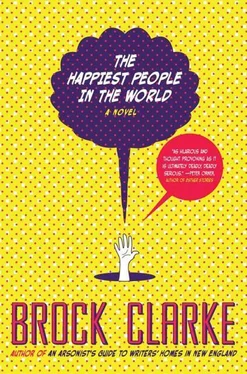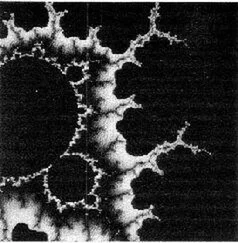Brock Clarke
The Happiest People in the World
He is the quintessential Dane, with his fear, his iron resolve to repress what’s happening around him. And his indomitable optimism.
— PETER HOEG, Smilla’s Sense of Snow
The game could continue, and now she could fight with her own weapons. Which she believed were pure.
— TOVE JANSSON, The True Deceiver
“I could kill him. . But would that be enough?”
— MURIEL SPARK, The Finishing School
The moose head was fixed to the wall, the microphone in its mouth was broken, but the camera in its left eye was working just fine, and as far as the moose head could see, this was just another Friday night in the Lumber Lodge! Perhaps even more Friday night than most Friday nights. In fact, it was barely evening at all — the camera had just begun recording, as it did every night, at 5 p.m. — but it looked a lot like closing time. The smoke, for instance! New York State law had been insisting for years now that no one was allowed to smoke in this bar or in any other bar, but this law, like most laws — including the United States’ laws preventing unauthorized surveillance of its citizens — was often ignored, and wow, was it being ignored tonight. The smoke was so thick the moose head was barely able to see the people it was intended to spy on. Finally, at 5:04 p.m., the smoke had thinned enough for the moose head to tell how very drunk all the people were. They were so very drunk that they were sprawled out on the floor, all of them — the boy who was clearly too young to be in the bar in the first place (another law broken, ignored); the blond woman who spent more time in the bar than anyone; the man who was wearing a red hat with a white letter C on it; the man who, along with the blond woman, the moose head had watched put up streamers all around the Lumber Lodge the day before; the woman and the man and the other man who had put the microphone and the camera in the moose head in the first place; the man with the ruined hand; the man with the garish shirt; the woman with the black hair who was clutching another red baseball hat with the white letter C on it; the man with the new haircut; the dark-skinned man the moose head had never seen before — all of them lying on the floor, obviously drunk, obviously completely plastered, grabbing at each other, reaching out for each other, yelling at each other (the moose head could not hear them but could see the O shapes their yelling mouths made), wrestling with each other, hugging each other, crawling away from and toward each other across the beer-and-booze-stained wooden floor. The stains were dark — darker than the usual stains — but then again these people were clearly drunker than the usual drunks, so they must have consumed alcohol darker and stronger than their usual alcohol. The moose head was not capable of judging these people; the moose head simply watched them the way the moose head had watched so many other drunks on so many other Friday nights. By 5:11 p.m. all but four of them had passed out. Among the still-conscious was one of the men who had put the microphone in the moose head’s mouth and the camera in its left eye. He pushed himself up on his elbows, looked confusedly around the room, as though not sure to which person, which people, he should attempt to crawl, and whether he wanted to help or hurt them. Finally the man shouted something at the moose head — which, of course, the moose head could not hear, because the man had not fixed or replaced the broken microphone — and then fell off his elbows and to the floor again. The man wearing the hat was also awake, and with his free hand he had taken the other red hat out of the black-haired woman’s hand and was attempting to place it on her head. He finally managed to do that. Then he, too, passed out. Across the room, the boy was on his knees, saying something to the blond woman. The moose head could not see the boy’s face now, but the boy’s shoulders were shaking, clearly with laughter. By 5:16 the boy had collapsed onto the blond woman’s chest. That left the man who had helped the blond woman put up the streamers the day before. The moose head could not think, but had it been able to, the streamers would have explained the extreme early drunkenness: it was a party! But anyway, the man was on his feet now. The moose head could see that on the floor, next to the man’s right foot, was a gun, and that there were several other guns scattered among the passed-out bodies. The moose head could not worry, any more than it could think or judge, but had the moose head been able to worry, the guns might have worried it. But maybe not. Because the man kicked the nearest gun as if the gun didn’t worry him even a little bit, kicked it away from the passed-out drunks and in the direction of the moose head, then kicked the rest of the guns in the direction of the moose head, as though this were a game, a game called kick the guns in the direction of the moose head. Then, when he was done with the game, he started running around the room, periodically bending over, shaking people, clearly having a good time fuckin’ with them (before the moose head’s microphone stopped working, the phrase it had most often heard coming out of the drunks in the Lumber Lodge was the phrase “Oh, I’m just fuckin’ with you”—“fuckin’ with you” apparently being the thing that the less drunk had a good time doing to the more drunk). Finally the man reached the blond woman and the boy. He knelt down next to them, his back facing the moose head. As with the boy, the moose head could not see the man’s face, but the moose head could see the man put his arms around the woman and the boy. The moose head watched the man hug them for a long time, watched his shoulders shaking harder even than the boy’s shoulders had, obviously laughing, just laughing and laughing as though he were the happiest person in the world, as though he knew that nothing bad would ever happen to him, or to any of them.
In September 2005 the Danish newspaper Jyllands-Posten published twelve editorial cartoons, many of them depicting the Islamic prophet Muhammad. The newspaper had solicited the cartoons, and published them along with an explanation: “Modern, secular society is rejected by some Muslims. They demand a special position, insisting on special consideration of their own religious feelings. It is incompatible with contemporary democracy and freedom of speech, where one must be ready to put up with insults, mockery, and ridicule. It is certainly not always attractive and nice to look at, and it does not mean that religious feelings should be made fun of at any price, but that is of minor importance in the present context. . We are on our way to a slippery slope where no-one can tell how the self-censorship will end. That is why Morgenavisen Jyllands-Posten has invited members of the Danish editorial cartoonists union to draw Muhammad as they see him.”
They did that. One cartoon — depicting Muhammad with a bomb in his turban — was particularly controversial. Once the cartoons became known outside Denmark — it took some time for them to become known — they caused several Middle Eastern countries to boycott Danish products and goods, and also caused protests and riots in several of those same countries and in Denmark as well. More than one hundred people were killed in these protests and riots. The Danish Embassy in Pakistan was bombed, and Denmark’s embassies in Syria, Lebanon, and Iran were set on fire. There have been several attempts and plots to kill the creator of the most controversial of the cartoons, and in 2010 the Danish police arrested five men who were suspected of planning an attack on the offices of Jyllands-Posten, the newspaper that first published the cartoons.
Читать дальше












